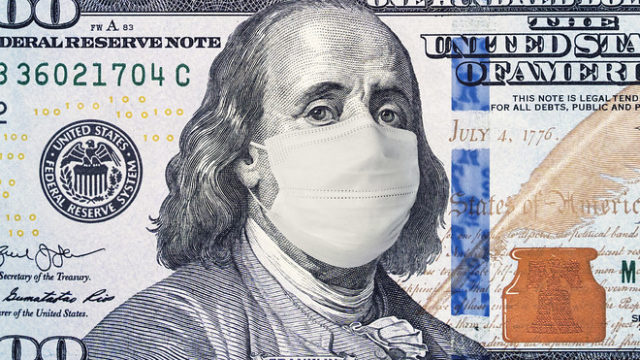Event Date: May 5, 2020
Higher taxes will be inevitable to help pay for the trillions of dollars the federal government is spending—creating, actually—to offset the economic contraction caused by the novel coronavirus pandemic. So says James Capretta, resident fellow at the American Enterprise Institute and former Office of Management and Budget associate director in President George W. Bush’s administration.
Since World War II the average annual federal budget deficit amounted to three percent of the gross domestic product (GDP), Capretta told participants in the Jewish Policy Center’s May 6 conference call, “Covid-19, Stimulus, and National Debt.” Legislation passed by Congress and signed by President Trump in March and April attempted to arrest the U.S. economy’s decline from best in 50 years to fastest shrinkage since the Great Depression. Trillions of dollars in new subsidies and loans, some forgivable, are going to businesses, institutions and individuals.

That means the average annual budget deficit for fiscal 2021 will reach 18 to 20 percent of GDP, Capretta said. “That’s just not something we’ve dealt with” in decades.
Perhaps more worrisome, “accumulated debt for fiscal 2021 is projected at 108 percent of GDP,” he added. “That is well beyond anything that’s occurred since World War II.” Ideally, debt should not exceed 80 percent of U.S. GDP, according to Capretta.
Debt in this case is the federal government’s annual budget shortfall. Deficit is the amount Washington owes as accumulated over years.
But “the crisis is so huge, potentially so damaging” that “now is not the time to scale back on all these [new] commitments,” he said. That is so even if the Federal Reserve System and U.S. Treasury’s new lending facilities and financial backstops essentially amount to running the printing presses “at a really massive rate” with potentially inflationary consequences.
‘A Mountain of Debt’
However, once effective treatments and a vaccine are developed—perhaps by 2023—it will be necessary to face “the mountain of debt that accumulated earlier” and should have been dealt with “two, three, four or five years ago when things were good.” Capretta, concurrently a senior advisor to the Bipartisan Policy Center and former senior health policy analyst for the U.S. Senate Budget Committee and House Ways and Means Committee, said he wasn’t blaming any one political party. But he noted “it’s always prudent to prepare for a rainy day, and now we’re in a hurricane” without having begun to fight the growth of federal indebtedness beforehand.
The cause of America’s fiscal squeeze is well-known, Capretta said, and it existed long before the current pandemic. It is “the growing mismatch between entitlement spending and revenue.”
Entitlement spending in the federal budget refers primarily to Social Security, Medicare and Medicaid. With an aging U.S. population, the mismatch will grow, continuing to restrict other government allocations, including defense.
“There’s no way to get into balance by making just cuts,” Capretta asserted. “There is always room for cuts,” but projected growth in entitlement spending and for interest payments on the debt—government bonds sold to investors including foreign governments, China’s among them—will demand new revenue as well. Meanwhile, projections including one from the Congressional Budget Office, put future debt-to-GDP in an economically burdensome range of 150 percent to 180 percent.
So long as the dollar remains the world’s preferred reserve currency and global investors continue willing to park their money in U.S. Treasury notes, “we might be okay for a long time,” Capretta said. “Until people say, ‘Wait a minute, you’re not as strong as we thought.’”
Even pre-pandemic, anticipations of an aging America, government revenue continuing relatively stable at 18 percent of GDP and a slowly growing economy pointed to “a recipe for a fiscal challenge of epic proportions,” Capretta said. Federal revenue might have to grow to 22 or 23 percent of GDP, meaning new taxes.
The Middle Class Pays
That will not be possible by only “raising taxes on the rich,” which Democrats frequently talk about but rarely implement, he added. Higher taxes on the wealthy alone won’t provide the necessary revenue so the middle class would have to pay more as well.
Capretta said both parties should aim first at stabilizing the federal debt and then “getting back to certainly under 100 percent of GDP and …eventually where we were” at 80 percent or less.
He believes the same bipartisanship that in the early 1980s managed to legislate a slowly phased boost to the Social Security retirement age from 65 to 67 will be needed again to similarly change Social Security and Medicare eligibility. Eligibility ages for the programs may need to rise to 69, for example. The earlier changes were controversial when debated, but became much less so once adopted, Capretta said.
Right now, he stated, “the U.S. government really has no budget plan,” nothing that starts with the revenue, debt and programs Washington has and says, “here’s what we’re trying to do over time.” After the pandemic, the current “quite messy” budget process needs to lead to a conversation on “here’s our target for 2030 …. What’s your plan for getting there?”
Capretta does not favor congressional bail-out for state governments facing potential bankruptcy, a policy being pushed by some Democrats. That would punish states able to meet their obligations because they kept spending in line with revenue and create a “moral hazard” of inducing some states to overspend in the future on the assumption the federal government would bail them out too.
He distinguished between pandemic responses by the federal government’s public health system and the country’s “bread-and-butter provision of health care by doctors, hospitals” and so on. Noting that it is still early in the pandemic, Capretta cautioned against demands to make major changes in U.S. health care.
He cited deficiencies on the public health side, including testing for the coronavirus and supplying equipment such as protective gear for health care workers. But in terms of providing medical treatment, even in New York City’s heavily burden hospitals, he said, “I don’t think there’s any evidence the United States has done poorly.” Emergency rooms and intensive care units were not perfect but preformed reasonably well, Capretta said. Government involvement is necessary, but medical care should be “responsive to competition,” he added.






